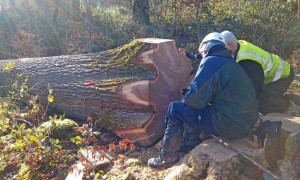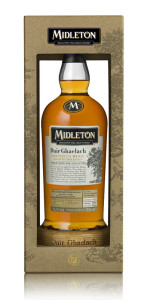Irish Oak Coming Back To Irish Whiskey
By Richard Thomas

(Credit: Richard Thomas)
Heretofore, whenever the subject of “new oak” comes up in reference to European whiskey-making, the wood in question was never from the whiskey’s country of origin. The whiskey might be Irish or Scottish, while the oak is almost invariably American, French or Spanish.
But no longer. New Midleton is ready to turn the corner on that mix of whiskey and wood, and is poised to release an aged pot still whiskey finished in new Irish oak.
No Trees, No Barrel Staves
Aged Irish whiskey must have relied on barrels made of native oak at one time, but logging and mass deforestation of the island country ended that long ago. The last time Irish oak was a staple of Irish whiskey was “at least 100 years ago,” says Kevin O’Gorman, New Midleton’s Master of Maturation. According to O’Gorman, Midleton’s records reveal the purchase of new Irish oak as far back as the 1820s, but not more recently.
Heavy logging turned Ireland into one of the most deforested countries in Europe, and by the 1970s forest cover was down to just 4% of the island’s territory. The Emerald Isle was green from its grass and hedges, not its trees. Obviously the lack of trees forced a variety of industries, including an Irish whiskey industry that dominated the world trade in whiskey in the 19th Century, to turn to imported timber to meet its needs.
That trend has reversed itself in recent decades, thanks to government and EU encouragement. Yet even though forest cover has now grown to 11%, Ireland remains among the most under-forested countries in the EU.
Irish Oak, Irish Whiskey
Compared to other regional oaks, Irish oak has a less dense, more open fiber structure. This is because it grows faster that American or European oak, due to a more favorable growing season. The wood also holds greater levels of some lignin derivative compounds, such as vanillin and vanillic acid, and furfural than other oaks.

(Credit: Irish Distillers)
The revival of interest in using Irish oak to age Irish whiskey is not unique to New Midleton. One of the Glendalough poitins is aged for a brief period of time in new Irish oak small barrels, and Cooley explored the idea of using Irish oak barrels prior to their 2011 acquisition by Beam Global. Yet it was New Midleton who put the idea into full effect.
The Irish oak project began with Kevin O’Gorman and Master Blender Billy Leighton roughly eight years ago. After a length period of experimentation, the decision was made to fell some trees, send the choice, cooperage-worthy parts to a sawmill in Galicia, Spain for cutting into staves, and hand the staves over to New Midleton’s standing cooperage in Jerez, Spain for barrel-making. After about two years of processing, the wood finally returns to Ireland.
A mix of pot still whiskeys, aged for 15 to 22 years, are then put into those new Irish oak barrels for a finishing of 10 months. The result is Midleton Dair Ghaelach, a whiskey that can make a firm claim to being as authentically Irish as anything around today. “It’s our barley, it’s our water, and it’s our oak,” says O’Gorman.
The Future Of Irish Oak
As already described, past incentives were enough to prompt Irish landowners to almost triple the forestation of Ireland in recent decades. If one adds to that the possibility of a lucrative wood products market, such as coopering timber, there is no reason why the booming Irish whiskey industry cannot drive the environmentally and ecologically desirable end of further expanding Ireland’s forest cover. “There is no reason why in 10 to 20 years time Irish oak cannot play a much larger role in Irish whiskey,” says O’Gorman.




